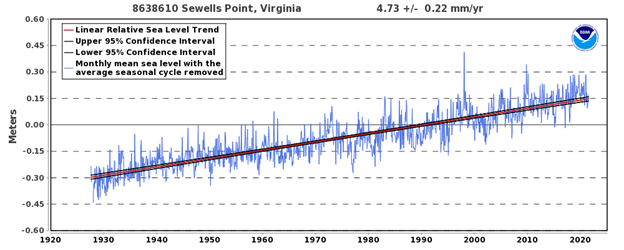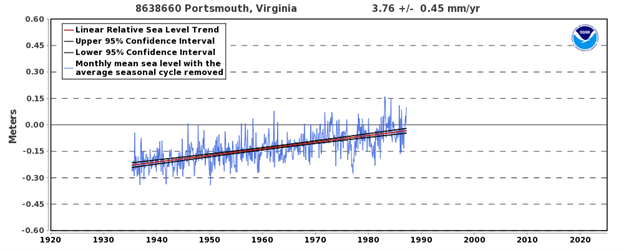Recently the Washington Post ran a story titled, “On the edge of retreat,” ascribing climate change induced sea level rise as the reason many of the remaining residents of Hog Island, Virginia are relocating to the mainland. This is false. The residents of Hog Island may be leaving their homes in the face of inexorable, long-standing sea level rise, erosion, and land subsidence on this barrier island, but there is no data supporting the claim that coastal Virginia has experienced an increasing rate of sea level rise over the past century’s modest warming.
The Washington Post (WP) gets some of its facts right, writing:
A century ago, about 250 people lived on Hog Island, a seven-mile expanse off the Virginia coast.
But that was back when there was still soil beneath their feet.
Historical maps show Hog Island’s shoreline was already retreating over a century ago. Seas were rising slowly then, in part due to sinking land, the legacy of the last major ice age.
At this point, however, the WP makes begins making claims refuted by available data, leading to gross speculation about future rates of sea level rise.
The menace today is different: human-caused climate change. Historically, the ocean has risen about a foot in a human lifetime, said John Porter, a University of Virginia scientist who studies the barrier islands. But because of climate change, that will be considerably higher going forward.
This is false, sea levels have not risen uniformly at a foot per century globally or in Virginia. Rather, they have risen at faster rates than at present for most of the past 12,000 years since the end of the ice age. Research shows, over the past century, some areas have experienced rates of measured sea level rise faster than a foot per century. Other areas have experiened slower rate rate of sea level rise, and still others have experienced a decline in sea levels.
Tide gauge data show no measurable increase in the rate of sea level rise in recent decades along coastal Virginia. As discussed in previous Climate Realism posts, here and here, the measured rate of sea level rise from locations along Virginia’s coast with long-term records show a steady, not accelerating, rate of rise. (see the figures below).



Each of these three locations are less than 50 miles from Hog Island, with one being just over 20 miles away. None of these tide gauges have seen an increase in the rate of sea level rise over the period of record keeping. The rate of rise at the site with the steepest rate would only produce an increase of 18 inches over the next century, not the 2 or three feet speculated in the Washington Post story. The rate of rise for the station nearest Hog Island, Kitopeke, would deliver 15 inches of sea level rise, about what the island experienced in the 19th and 20th centuries.
Of course, the residents of Hog Island might have experienced a greater perceived rate of rise over the past century than has been measured at official tide gauge stations. If so, that is likely due to it being a barrier island where lands and coasts shift due to the tides and storms resulting in erosion that is higher than that experienced on the mainland that barrier islands insulate from storms worst effects. In addition, as with nearby Chesapeake Bay, land is likely subsiding. Land subsidence has been observed since the 1940s in the southern Chesapeake Bay region at rates of 1.1 to 4.8 millimeters per year (mm/yr), continuing to today.
The authors of the Washington Post story are well aware of the myriad factors contributing to the decline of Hog Island, and that Hog Island was shrinking long before humans began contributing to climate change. As proof, they mentioned each factor in their story. Yet, data be damned, they still tried to link the woes of Hog Island’s residents to climate change. This is the sorry state of affairs for much of modern journalism. Writing a story to fit the preconceived narrative that humans are causing a climate crisis, while ignoring facts that undermine the narrative; in this case, hard tide gauge data.


















